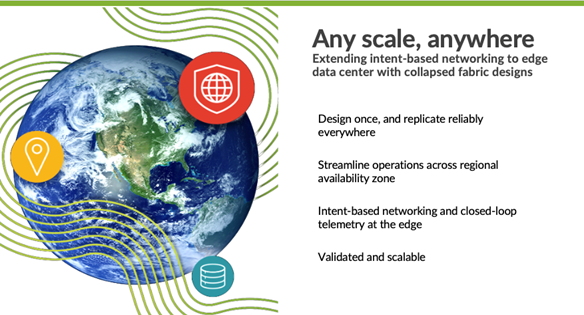Data centers are massive, warehouse-like structures with rows and rows of racks of computer equipment supported by elaborate power, cooling, and connectivity infrastructure, right?
Not necessarily. Today, a new class of ‘mini’ data center is an important part of both enterprise and telco service provider portfolios. These smaller facilities fit into many form factors and locations, from telco points of presence to retail ‘phone closets.’
Given their fundamental physical differences, it makes sense that the principles for architecting them – both hardware and software infrastructure – will be markedly different from the familiar large-scale facilities, especially when different brands of hardware across each mini data center adds to the overall complexity.
There is more to this story, however. Mini data centers are like Lay’s potato chips – you’re never satisfied with just one. Instead, organizations are implementing vast numbers of these facilities, requiring a different approach to data center architecture we call a fabric.
Envisioning the Edge Data Center Fabric

The primary reason to implement an edge data center fabric in the first place is to move compute resources closer to the users of those resources, either to reduce latency or to reduce costs in other ways.
Such fabrics constitute what we now call the near edge – as opposed to the cloud edge (where CDNs operate) and the far edge (where user devices and IoT sensors and actuators live).
In keeping with the ‘simpler is better’ maxim, sometimes it makes sense for each individual mini data center to be identical to all the others. This cookie cutter approach is occasionally practical, but there are several situations where it is not:
- When business requirements for each mini data center varies across the fabric
- When hardware, connectivity, or software infrastructure updates drive differences among data centers
- When physical constraints (size, power availability, connectivity options, etc.) necessitate unique data center configurations
As a result, expect the typical edge data center fabric to have diverse, dynamic configurations requiring an approach to data center architecture and management more sophisticated than traditional data centers require.
Common Edge Data Center Fabric Use Cases
While traditional data centers offer largely general-purpose capabilities, architecting and managing an edge data center fabric depends in large part on the purpose for each mini data center.
Edge computing is still nascent, but there are certain use cases that have become prominent examples of edge data center fabric applications:
- Factory and warehouse applications, especially involving robotics and computer vision
- Video security applications that leverage deep learning to identify suspicious behavior
- Retail ‘phone closets’ supporting point-of-sale and other local capabilities in each store or restaurant
In many cases (especially those situations involving video), AI inferencing takes place at the near edge. Inferencing requires real-time processing of massive data sets – taking advantage of the lower latency on the edge as well as reducing bandwidth, ingress, storage, and other cloud costs.
Even when AI is not necessarily involved (as with the retail scenario), companies still find that data processing on the edge is a central application of their mini data centers.
For the telco service provider, furthermore, all these use cases are relevant – and more. Not only does the service provider have to support current customer edge data center fabric requirements, but it must also facilitate the ongoing deployment of 5G technologies as they become increasingly central to edge fabric architectures.
Edge Data Center Fabric Architecture Challenges
In addition to the diverse and frequently dynamic nature of mini data centers and the applications that run in them, every organization that seeks to deploy such a fabric must deal with the fact that staffing each data center becomes increasingly unrealistic as the fabric expands.
Clearly, a restaurant or retail store chain will not be able to place IT personnel in every location. Even the larger installations like factories and warehouses – which will have a modest IT staff – cannot expect those personnel to support the mini data center the way that the staff of a traditional data center would.
Every data center architect, therefore, must leverage automation across the fabric, even more so than in a traditional data center. Such automation itself must be sufficiently resilient to respond to most incidents that might arise in each data center.
Automation alone, however, isn’t the whole answer. It’s also essential to implement a comprehensive declarative control plane that supports policy-based configuration across the entire fabric.
This comprehensive abstraction is fundamentally a cloud native best practice, and thus is essential to achieving the scale and resiliency requirements that all modern IT infrastructure requires, including edge data center fabrics.
In fact, without such a policy-based abstraction, the notion of a ‘fabric’ no longer holds water – it becomes nothing more than a collection of separate mini data centers that require individual architectures and management practices.
Once this policy-based abstraction is in place and the edge data center fabric begins to grow, then intent-based management approaches, intent-based networking, in particular, become essential to the ongoing resiliency of the fabric.

Juniper Apstra provides intent-based networking that enables data center architects to specify policy-based control plane abstractions – not only within individual data centers, but across the entire fabric, from within a single instance of Apstra. It allows customers to manage data center networks from a single pane of glass with reliability, consistency, and multivendor support.
This ability to provide resiliency across data centers via a unified control plane that not only implements policy-based, pre-validated configurations, but also ensures that the mini data centers as deployed remain in compliance with such configurations, differentiates Apstra from all traditional data center management products on the market.
The Intellyx Take
There’s an old joke among computer scientists that there are in reality only three numbers: zero, one, and n, where n can vary up to some calculated maximum.
Such is true of data center architecture as well. There’s no sense architecting for two, or five, or any other particular number of data centers. Once you get past one, you must architect for an arbitrary, varying number of such facilities.
For this reason, ‘fabric thinking’ is essential to the role of the edge data center fabric architect.
Both enterprises and the service providers that serve them must implement configuration-based control planes across the entire fabric, leveraging automation and intent-based networking principles to support the business requirements for each individual data center, while planning ahead for the resiliency necessary to deal with unexpected disruptions.
Copyright © Intellyx LLC. Juniper Networks is an Intellyx customer. Intellyx retains final editorial control of this article. Image credit: Barney Livingston.



